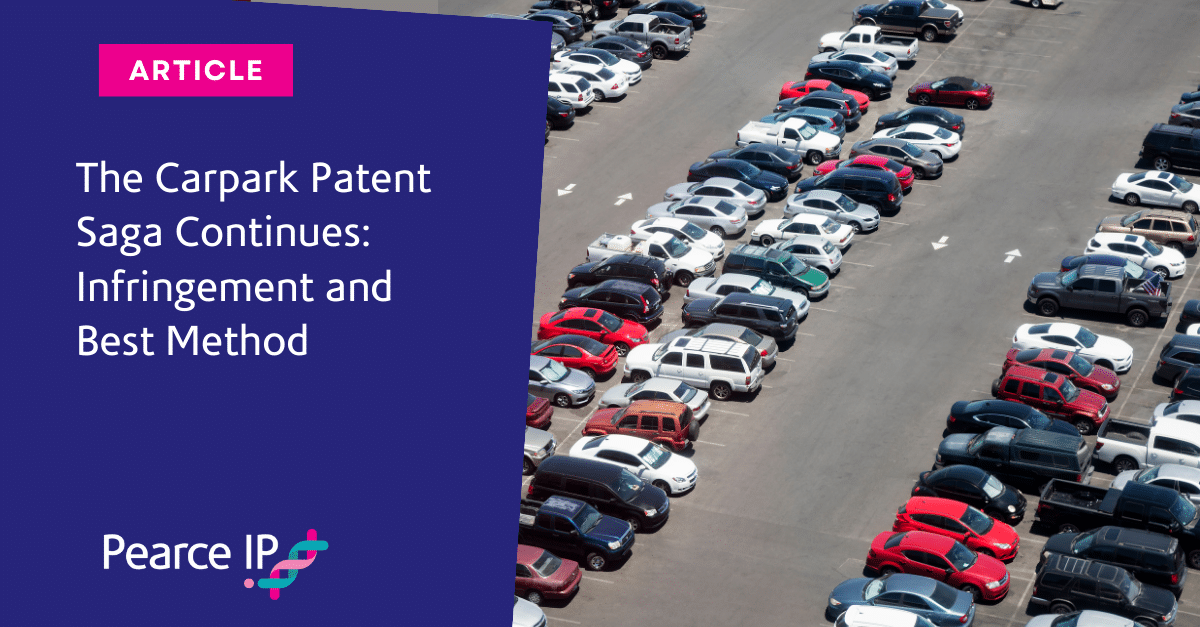Date:
Court:
Adjudicator:
09 February 2024
Full Court of the Federal Court Australia
Burley, Jackson and Downes JJ
Highlight
The Full Federal Court has overturned the primary judge’s decision on construction and infringement (with respect to PinForce version 3) but upheld the primary judge’s decision on best method, in the latest case to be heard and decided in the long-running patent disputes between arch rivals in the field of carpark overstay detection.
Background
Vehicle Monitoring Systems (VMS) is the registered owner of two standard Australian patents, AU2005243110 and AU2011204924 (the standard patents), both entitled “Method, apparatus and system for parking overstay detection”. The invention relates to monitoring the presence of a vehicle in a parking space over a specified time period via a detection apparatus located under the parking space in order to detect vehicles which overstay. The main claim features relate to a method, apparatus and system incorporating the following steps or components for performing them:
- detecting presence of a vehicle in said parking space;
- processing and storing data relating to presence of said vehicle in the parking space;
- determining whether the vehicle has overstayed in the parking space; and
- wirelessly transmitting data relating to identified instances of vehicle overstay.
In February 2019 VMS commenced infringement proceedings against SARB Management Group Pty Ltd and its customer City of Melbourne in respect of three versions of SARB’s vehicle detection and sensor system known as ‘PinForce’. SARB cross-claimed for invalidity. In March 2023 Justice Besanko upheld the validity of the two VMS patents and found all three versions to be infringing. SARB was also held liable for additional damages under s 122(1A) of the Patent Act 1990 (Cth) (Act) in respect of the first two iterations of the PinForce system in light of findings of infringement for a related innovation patent in earlier proceedings. We reported Justice Besanko’s decision in a blog, in our Case Summary and this case was included in the Pearce IP 2023 Annual Patent Case Review.
SARB’s appeal to the Full Court of the Federal Court was confined to two issues:
- construction and infringement of certain claims of AU2005243110, with respect to PinForce version 3; and
- the primary judge’s finding that SARB had not established that the claims were invalid for lack of best method.
SARB succeeded on construction and infringement, but failed to prove lack of best method.
Key Issues
Construction and infringement
SARB’s challenge focussed on construction of independent claim 21 and omnibus claims 30-32. Specifically, claim 21 covers:
- ‘a system for identifying overstay of vehicles in parking spaces, said system comprising:
- a plurality of battery-powered detection apparatuses for identifying overstay of vehicles in respective parking spaces when subterraneously installed; and
- a data collection apparatus for wirelessly retrieving data from said plurality of battery-powered detection apparatuses, said data collection apparatus comprising:
- …a processing unit coupled to said radio transmitter, said radio receiver and said memory unit;
- said processing unit programmed to process said data received via said radio receiver and to indicate incidences of vehicle overstay to an operator;
- said data relates to identified instances of vehicle overstay in a respective parking space’.
The primary judge construed the claim to include a system whereby the wireless ‘data collection apparatus’ (DCA) performed detection overstay utilising data sent by the subterranean ‘detection apparatus’ (DA) which comprised vehicle arrival time and duration but might fall short of overstay determination.
SARB contended that the primary judge should have found that claim 21 was limited to a system in which vehicle overstay is determined solely by the DA, and that such decision should then flow on to the omnibus claims.
In forming his view on construction of claim 21, the primary judge relied on:
- the evidence of both parties’ experts, who agreed that the system disclosed in the patent was capable of determining overstay in the data collection apparatus; and
- the body of the specification to aid his construction of claim 21, given that his Honour considered the phrase “said data relates to identified instances of vehicle overstay in a respective parking space” in claim 21 to be ambiguous. In particular, his Honour considered that there was an ambiguity in the phrase between data which includes the identified instances of vehicle overstay, that is, the determination of vehicle overstay, and data which may lead to the identification of instances of vehicle overstay.
His Honour concluded that the ambiguity in claim 21 should be resolved by holding that it includes a system in which vehicle overstay is determined by the DCA having regarding to a specific passage on page 7 (which stated “Alternatively, decisions relating to a vehicle overstay can be made by a data collection apparatus that collects data from the apparatus 200 via a radio communication link rather than by the apparatus 200”) , and, to a lesser extent, other passages relied on by VMS and its expert witness.
While the Full Court noted that the principles of claim construction are not in dispute, the Full Court disagreed with the primary judge that there was any ambiguity in claim 21. In the Full Court’s view, the phrase “said data relates to identified instances of vehicle overstay in a respective parking space” (emphasis added) refers to data that relates to identified instances of vehicle overstay. The Full Court went on to state at [60]:
As a matter of language, we understand this to mean first, that the detection apparatus will have already “identified” instances of vehicle overstay at the point that the data arrives at the processing unit. Secondly, the phrase “relates to” indicates that the “said data” not only consists of identified instances of overstay, but data that relates to it, such as details of current status, the amount of time the parking space has remained in the present state and records of vehicle movements.
As a result, SARB also succeeded on claim 32 (the counterpart omnibus claim to claim 21). In addition, SARB succeeded on claims 30 and 31, as VMS accepted that these claims did not disclose a method or apparatus in which the DCA determined vehicle overstay.
Best method
SARB also appealed the primary judge’s finding that SARB failed to establish the patents were invalid on the ground of best method. The basis of SARB’s argument on best method was that the patent did not describe a specific transceiver (the ASTRX2 transceiver), even though it was known to the inventor to have advantages which made it the best transceiver for communicating data from the subterraneous detection apparatus. These advantages related to its ‘wake-up’ method, ie the manner in which it woke up to receive the data. SARB’s argument was not specifically to failure to disclose the transceiver per se, but failure to fully disclose the wake-up scheme of the invention because the patent did not describe the ASTRX2 transceiver. The Full Court rejected SARB’s argument, agreeing with the primary judge that the invention of the patents related to the wake-up scheme and not the wake-up scheme as carried out by a transceiver with particular features. In coming to this conclusion, the Court emphasised the significance of the embodiments in the specification in identifying the invention, whereas SARB had focussed on the consistory clauses to the challenged claims. The Court held the disclosure was adequate because the parameters of the wake-up scheme were clearly disclosed in the specification, and there was no evidence that transceivers other than the ASTRX2 could not meet those parameters.
Outcome
The Full Court overturned the primary judge’s decision finding that the claims should be construed to encompass a system where vehicle detection is determined by the DCA. The effect of this change in construction was that the PinForce version 3 was held to fall outside the claims. It was agreed by all experts before Justice Besanko that in the case of PinForce Version 3, all capability of determining overstay in the DA had been removed following a redesign.
However, the Full Court agreed with the primary judge on best method, holding that SARB had not proved a failure to disclose the best method.
Implications
The Full Court’s decision clearly illustrates the principles applied to claim construction including that the scope of an otherwise clear claim cannot be broadened or changed based on language drawn from the body of the specification. The Full Court’s decision also confirms the narrow construction which Courts give to omnibus claims. It also provides further guidance on the ground of lack of best method, a revocation ground peculiar to Australia and one which has been increasingly run in Australia over the last decade. In particular, the Full Court’s judgment highlights the importance of identifying the invention the subject of the patent to the determination of whether the patent has met the best method disclosure requirement.
About Pearce IP
Pearce IP is a boutique firm offering intellectual property specialist lawyers, patent attorneys and trade mark attorneys to the life sciences industries (in particular, pharmaceutical, biopharmaceutical, biotech, ag-tech and food tech). Pearce IP is the 2021 ‘Intellectual Property Team of the Year’ (Lawyers Weekly Australian Law Awards) and was shortlisted for the same award in 2022. Pearce IP is ranked in IAM Patent 1000 and Managing IP (MIP) IP Stars, in Australasian Lawyer 5 Star Awards as a ‘5 Star’ firm, and the Legal 500 APAC Guide for Intellectual Property.
Our leaders have been recognised in virtually every notable IP listing for their legal, patent and trade mark excellence including: IAM Patent 1000, IAM Strategy 300, MIP IP Stars, Doyles Guide, WIPR Leaders, 5 Star IP Lawyers, Best Lawyers, and Australasian Lawyer 5 Star Awards, and have been honoured with many awards including Australian Law Awards – IP Partner of the Year, Women in Law Awards – Partner of the Year, Women in Business Law Awards – Patent Lawyer of the Year (Asia Pacific), Most Influential Lawyers (Changemaker), among other awards.

Naomi Pearce
CEO, Executive Lawyer (AU, NZ), Patent & Trade Mark Attorney (AU, NZ)
Naomi is the founder of Pearce IP, and is one of Australia’s leading IP practitioners. Naomi is a market leading, strategic, commercially astute, patent lawyer, patent attorney and trade mark attorney, with over 25 years’ experience, and a background in molecular biology/biochemistry. Ranked in virtually every notable legal directory, highly regarded by peers and clients, with a background in molecular biology, Naomi is renown for her successful and elegant IP/legal strategies.
Among other awards, Naomi is ranked in Chambers, IAM Patent 1000, IAM Strategy 300, is a MIP “Patent Star”, and is recognised as a WIPR Leader for patents and trade marks. Naomi is the 2023 Lawyers Weekly “IP Partner of the Year”, the 2022 Lexology client choice award recipient for Life Sciences, the 2022 Asia Pacific Women in Business Law “Patent Lawyer of the Year” and the 2021 Lawyers Weekly Women in Law SME “Partner of the Year”. Naomi is the founder of Pearce IP, which commenced in 2017 and won 2021 “IP Team of the Year” at the Australian Law Awards.

Helen Macpherson
Executive, Lawyer
Helen has over 25 years’ experience as an intellectual property specialist and is recognised as an industry leader. Helen advises on all forms of intellectual property including patents, plant breeder’s rights, trade marks, copyright and confidential information across a wide range of industries, including the pharmaceutical/biopharmaceutical, biotechnology, medical device, life sciences, agricultural, manufacturing and tech sectors.

